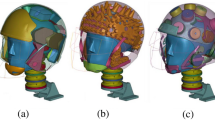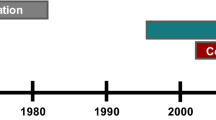Abstract
Concussion awareness in youth sports has increased secondary to recent legislation, public health campaigns, and media coverage. The potential for long-term negative sequelae is now widely recognized and there have been a number of initiatives nationwide to prevent pediatric head injuries, including efforts to design more effective helmets for repetitive impact sports. The primary aim of this review is to systematically assess the literature regarding helmet design in youth sports specifically designed to mitigate repetitive low- and medium-energy impacts. Secondary aims include identifying areas for future research and opportunities for helmet design improvement. A systematic review of the literature was performed to identify articles relating to youth helmet design and biomechanical studies of concussion in youth sports. Pubmed, Google scholar, Cochrane Review and article citations were used to identify all pertinent English articles between 1971 and January 2016. A total of 14 studies met criteria for inclusion in this review, three of which included clinical outcomes (all Level of Evidence II) and eleven of which included biomechanical outcomes. The vast majority focused on adolescents playing football. Six of the biomechanical studies demonstrated improved biomechanical metrics in helmets with increasing foam thickness and number of foam layers. Two clinical studies also seem to support this concept, with significant caveats. To date, there are limited clinical and biomechanical data on youth helmet design. There is a need for further research in order to optimize helmet design and reduce the number and severity of pediatric sports-related head injuries.


Similar content being viewed by others
References
Bauer R, Fritz H (2004) Pathophysiology of traumatic injury in the developing brain: an introduction and short update. Exp Toxicol Pathol Off J Ges Für Toxikol Pathol 56:65–73. doi:10.1016/j.etp.2004.04.002
Baillargeon A, Lassonde M, Leclerc S, Ellemberg D (2012) Neuropsychological and neurophysiological assessment of sport concussion in children, adolescents and adults. Brain Inj 26:211–220. doi:10.3109/02699052.2012.654590
Field M, Collins MW, Lovell MR, Maroon J (2003) Does age play a role in recovery from sports-related concussion? A comparison of high school and collegiate athletes. J Pediatr 142:546–553. doi:10.1067/mpd.2003.190
McCrory P, Meeuwisse WH, Aubry M et al (2013) Consensus statement on concussion in sport: the 4th International Conference on Concussion in Sport held in Zurich, November 2012. J Am Coll Surg 216:e55–e71. doi:10.1016/j.jamcollsurg.2013.02.020
Danelson KA, Geer CP, Stitzel JD et al (2008) Age and gender based biomechanical shape and size analysis of the pediatric brain. Stapp Car Crash J 52:59–81
Hodgson VR (1975) National Operating Committee on Standards for Athletic Equipment football helmet certification program. Med Sci Sports 7:225–232
Gurdjian ES, Roberts VL, Thomas LM (1966) Tolerance curves of acceleration and intracranial pressure and protective index in experimental head injury. J Trauma 6:600–604
Cantu RC, Mueller FO (2003) Brain injury-related fatalities in American football, 1945–1999. Neurosurgery 52:846–852 (discussion 852–853)
Boden BP, Tacchetti RL, Cantu RC et al (2007) Catastrophic head injuries in high school and college football players. Am J Sports Med 35:1075–1081. doi:10.1177/0363546507299239
Rowson S, Duma SM (2011) Development of the STAR evaluation system for football helmets: integrating player head impact exposure and risk of concussion. Ann Biomed Eng 39:2130–2140. doi:10.1007/s10439-011-0322-5
Viano DC, Halstead D (2012) Change in size and impact performance of football helmets from the 1970s to 2010. Ann Biomed Eng 40:175–184. doi:10.1007/s10439-011-0395-1
Football Helmet Buying Guide. (2015). http://www.sportsunlimitedinc.com/football-helmet-buyers-guide.html. Accessed 24 Mar 2015
Bushby KM, Cole T, Matthews JN, Goodship JA (1992) Centiles for adult head circumference. Arch Dis Child 67:1286–1287
Wright CM, Booth IW, Buckler JMH et al (2002) Growth reference charts for use in the United Kingdom. Arch Dis Child 86:11–14
National Center for Health Statistics, National Center for Chronic Disease Prevention and Health Promotion (2000) 2 to 20 years: Boys Stature-for-age and Weight-for-age percentiles
Rowson S, Duma SM, Greenwald RM et al (2014) Can helmet design reduce the risk of concussion in football? J Neurosurg 120:919–922. doi:10.3171/2014.1.JNS13916
Collins M, Lovell, Iverson GL et al (2006) Examining concussion rates and return to play in high school football players wearing newer helmet technology: a three-year prospective cohort study. Neurosurgery 58:275–286. doi:10.1227/01.NEU.0000200441.92742.46 (discussion 275–286)
Virginia Tech Helmet Ratings. (2015). http://www.sbes.vt.edu/helmet.php. Accessed 12 Mar 2015
McGuine TA, Hetzel S, McCrea M, Brooks MA (2014) Protective equipment and player characteristics associated with the incidence of sport-related concussion in high school football players: a multifactorial prospective study. Am J Sports Med 42:2470–2478. doi:10.1177/0363546514541926
Bartsch A, Benzel E, Miele V, Prakash V (2012) Impact test comparisons of 20th and 21st century American football helmets. J Neurosurg 116:222–233. doi:10.3171/2011.9.JNS111059
Nakatsuka AS, Yamamoto LG (2014) External foam layers to football helmets reduce head impact severity. Hawaii J Med Public Health J Asia Pac Med Public Health 73:256–261
Pellman EJ, Viano DC, Withnall C et al (2006) Concussion in professional football: helmet testing to assess impact performance–part 11. Neurosurgery 58:78–96 (discussion 78–96)
Viano DC, Withnall C, Halstead D (2012) Impact performance of modern football helmets. Ann Biomed Eng 40:160–174. doi:10.1007/s10439-011-0384-4
Viano DC, Pellman EJ, Withnall C, Shewchenko N (2006) Concussion in professional football: performance of newer helmets in reconstructed game impacts–Part 13. Neurosurgery 59:591–606. doi:10.1227/01.NEU.0000231851.97287.C2 (discussion 591–606)
Caswell SV, Deivert RG (2002) Lacrosse helmet designs and the effects of impact forces. J Athl Train 37:164–171
Forero Rueda MA, Cui L, Gilchrist MD (2011) Finite element modelling of equestrian helmet impacts exposes the need to address rotational kinematics in future helmet designs. Comput Methods Biomech Biomed Engin 14:1021–1031. doi:10.1080/10255842.2010.504922
Hrysomallis C (2004) Impact energy attentuation of protective football headgear against a yielding surface. J Sci Med Sport Sports Med Aust 7:156–164
Rowson S, Daniel RW, Duma SM (2013) Biomechanical performance of leather and modern football helmets. J Neurosurg 119:805–809. doi:10.3171/2013.3.JNS121735
Hoshizaki B, Vassilyadi M, Post A, Oeur A (2012) Performance analysis of winter activity protection headgear for young children. J Neurosurg Pediatr 9:133–138. doi:10.3171/2011.11.peds11299
Sun PP, Poffenbarger GJ, Durham S, Zimmerman RA (2000) Spectrum of occipitoatlantoaxial injury in young children. J Neurosurg 93:28–39
Ommaya AK, Hirsch AE (1971) Tolerances for cerebral concussion from head impact and whiplash in primates. J Biomech 4:13–21
Daniel RW, Rowson S, Duma SM (2012) Head impact exposure in youth football. Ann Biomed Eng 40:976–981. doi:10.1007/s10439-012-0530-7
Cobb BR, Urban JE, Davenport EM et al (2013) Head impact exposure in youth football: elementary school ages 9-12 years and the effect of practice structure. Ann Biomed Eng. doi:10.1007/s10439-013-0867-6
Urban JE, Davenport EM, Golman AJ et al (2013) Head impact exposure in youth football: high school ages 14 to 18 years and cumulative impact analysis. Ann Biomed Eng. doi:10.1007/s10439-013-0861-z
Wong RH, Wong AK, Bailes JE (2014) Frequency, magnitude, and distribution of head impacts in Pop Warner football: the cumulative burden. Clin Neurol Neurosurg 118:1–4. doi:10.1016/j.clineuro.2013.11.036
Young TJ, Daniel RW, Rowson S, Duma SM (2014) Head impact exposure in youth football: elementary school ages 7–8 years and the effect of returning players. Clin J Sport Med Off J Can Acad Sport Med 24:416–421. doi:10.1097/JSM.0000000000000055
Hibbeler RC (1974) Engineering mechanics: statics and dynamics. Macmillan Publishing, New York
A guide to polycarbonate in general. (2016). http://www.ptsllc.com/intro/polycarb_intro.aspx. Accessed 20 Jan 2016
Polycarbonate typical properties generic. (2016). http://plastics.ulprospector.com/generics/25/c/t/polycarbonate-pc-properties-processing. Accessed 20 Jan 2016
Acrylonitrile butadiene styrene (ABS) typical properties generic ABS. (2016). http://plastics.ulprospector.com/generics/1/c/t/acrylonitrile-butadiene-styrene-abs-properties-processing. Accessed 20 Jan 2016
Juliusson PB, Roelants M, Nordal E et al (2013) Growth references for 0–19 year-old Norwegian children for length/height, weight, body mass index and head circumference. Ann Hum Biol 40:220–227. doi:10.3109/03014460.2012.759276
Wingo JC (2016) Interview with Wingo Sports Labs
Collins CL, Fletcher EN, Fields SK et al (2014) Neck strength: a protective factor reducing risk for concussion in high school sports. J Prim Prev 35:309–319. doi:10.1007/s10935-014-0355-2
Schmidt JD, Guskiewicz KM, Blackburn JT et al (2014) The influence of cervical muscle characteristics on head impact biomechanics in football. Am J Sports Med 42:2056–2066. doi:10.1177/0363546514536685
Eckner JT, Oh YK, Joshi MS et al (2014) Effect of neck muscle strength and anticipatory cervical muscle activation on the kinematic response of the head to impulsive loads. Am J Sports Med 42:566–576. doi:10.1177/0363546513517869
Taheri M, Kajbaf TZ, Taheri M-R, Aminzadeh M (2016) Neck circumference as a useful marker for screening overweight and obesity in children and adolescents. Oman Med J 31:170–175. doi:10.5001/omj.2016.34
Hutchinson TP (2014) Peak acceleration during impact with helmet materials: effects of impactor mass and speed. Eur J Sport Sci 14(Suppl 1):S377–S382. doi:10.1080/17461391.2012.705334
Baschera D, Hasler RM, Taugwalder D et al (2015) association between head injury and helmet use in alpine skiers: cohort study from a Swiss level i trauma center. J Neurotrauma 32:557–562. doi:10.1089/neu.2014.3604
Jadischke R, Viano DC, Dau N et al (2013) On the accuracy of the Head Impact Telemetry (HIT) System used in football helmets. J Biomech 46:2310–2315. doi:10.1016/j.jbiomech.2013.05.030
Shaw NA (2002) The neurophysiology of concussion. Prog Neurobiol 67:281–344
Standard performance specification for newly manufactured football helmets. (2015). http://nocsae.org/wp-content/files_mf/1396898424ND00213m13MfrdFBHelmetsStandardPerformance.pdf. Accessed 16 Aug 2016
(2013) Lower severity index equals lower concussion risk. (2016). http://www.echelonsportsarmor.com/news/sev-index-concussions-compilation.pdf. Accessed 20 Jan 2016
NOCSAE severity index FAQs. (2016). http://nocsae.org/wp-content/uploads/2011/10/NOCSAE-Severity-Index-FAQs-1-2015.pdf. Accessed 20 Jan 2016
Davenport EM, Whitlow CT, Urban JE et al (2014) Abnormal white matter integrity related to head impact exposure in a season of high school varsity football. J Neurotrauma. doi:10.1089/neu.2013.3233
Dashnaw ML, Petraglia AL, Bailes JE (2012) An overview of the basic science of concussion and subconcussion: where we are and where we are going. Neurosurg Focus 33(E5):1–9. doi:10.3171/2012.10.FOCUS12284
Standard performance specification for newly manufactured football helmets. Proposed standard. (2016). http://nocsae.org/wp-content/files_mf/1451499468ND00216MfrdFBHelmetsStandardPerformance.pdf. Accessed 16 Aug 2016
Standard performance specification for newly manufactured youth football helmets. Draft version. (2011). http://nocsae.org/wpcontent/files_mf/1351111531ND00611m11MfrdYouthFBHelmetsStandardPerformance.pdf. Accessed 16 Aug 2016
Broglio SP, Eckner JT, Kutcher JS (2012) Field-based measures of head impacts in high school football athletes. Curr Opin Pediatr 24:702–708. doi:10.1097/MOP.0b013e3283595616
Forbes JA, Awad AJ, Zuckerman S et al (2012) Association between biomechanical parameters and concussion in helmeted collisions in American football: a review of the literature. Neurosurg Focus 33(E10):1–6. doi:10.3171/2012.9.FOCUS12288
Beckwith JG, Greenwald RM, Chu JJ (2012) Measuring head kinematics in football: correlation between the head impact telemetry system and Hybrid III headform. Ann Biomed Eng 40:237–248. doi:10.1007/s10439-011-0422-2
The Guardian Cap. (2016). http://www.guardiancaps.com/theguardiancap/. Accessed 20 Jan 2016
Unequal Accleration Reduction Technology. (2016). http://www.unequal.com/technology/. Accessed 20 Jan 2016
Helmet Glide by Diamond Seal Sports. (2016). http://diamond-seal-systems.myshopify.com/pages/helmet-glide-by-diamond-seal-sports. Accessed 20 Jan 2016
Shockstrip. (2016). http://jumpanswers.com/. Accessed 20 Jan 2016
Walter KD (2013) No evidence that helmet add-ons reduce concussion risk. AAP News 34:17–17. doi:10.1542/aapnews.20133410-17
Cantu RC (2015) Concussive and sub-concussive head trauma-how can it be prevented/minimized. Concussion summit 2015: from impact to recovery. Children's of Alabama. Birmingham, AL
Acknowledgments
This study was supported by a grant from the Kaul Foundation.
Author information
Authors and Affiliations
Corresponding author
Ethics declarations
Funding
None. The authors have no financial support or industry affiliations to report. The authors have no personal or institutional financial interest in drugs, materials or devices described in this submission.
Rights and permissions
About this article
Cite this article
Kuhn, E.N., Miller, J.H., Feltman, B. et al. Youth helmet design in sports with repetitive low- and medium-energy impacts: a systematic review. Sports Eng 20, 29–40 (2017). https://doi.org/10.1007/s12283-016-0215-9
Published:
Issue Date:
DOI: https://doi.org/10.1007/s12283-016-0215-9




